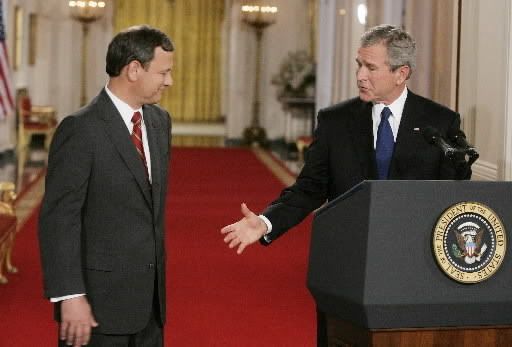
Yesterday’s ruling that Obamacare’s individual mandate exceeded Congress’ power under the Commerce Clause showcased the Supreme Court at its intellectual best: the fruits of years of detailed and heated scholarly and judicial debate, intensive briefing and vigorous argument were reflected in the various opinions. Unfortunately, the same cannot be said of the Court’s opinions on the alternative ground – the taxing power – that Chief Justice Roberts and the Court’s four Democratic appointees found to be an alternative basis for the mandate. Critics on the Right have assumed that Roberts is wrong about the taxing power, and the cheerleaders on the Left are simply pocketing the result, but neither the various opinions nor most of the commentary have bothered to explain a theory of what Congress can and cannot constitutionally do through its power to tax.
The Majority
In theory, the powers of the federal government should be determined by examining first the Constitution’s text and then the caselaw. While there are different schools of thought on how to handle the text, the conservative “originalist” argument is that it should be read in light of how that text was commonly understood at the time it was adopted, since the time of adoption is when the consent of the governed was given to the text. But Part III(C) of Chief Justice Roberts’ opinion for the Court, comprising p. 33-44 of the opinion, spends almost no time actually looking at the scope or original meaning of the taxing power.
The very first power granted to Congress in Article I, Section 8, is the power to tax:
The Congress shall have Power To lay and collect Taxes, Duties, Imposts and Excises, to pay the Debts and provide for the common Defence and general Welfare of the United States; but all Duties, Imposts and Excises shall be uniform throughout the United States
Section 9 adds a limitation: “No capitation, or other direct, Tax shall be laid, unless in Proportion to the Census or Enumeration herein before directed to be taken.” However, unlike the Commerce Clause and the Spending Clause, which remain unchanged from their original 1787 text, this aspect of the taxing power has been altered by the Sixteenth Amendment, ratified in 1913, which states: “The Congress shall have power to lay and collect taxes on incomes, from whatever source derived, without apportionment among the several States, and without regard to any census or enumeration.”
To begin with, the Court’s opinion has to thread a very narrow needle in explaining how the mandate is a tax for purposes of the Constitutional power to tax, but not a tax for purposes of the Anti-Injunction Act, which would have barred the Court from deciding the issue until someone actually paid the penalty for not having insurance and sued for a refund, which could happen no sooner than 2014. The resulting explanation – that when Congress calls something a penalty that makes it a penalty for purposes of statutory construcution, while the label should be disregarded in favor of the substance for purposes of constitutionality – is not completely implausible, but it is surely not one that you could come up with if you did not begin the exercise with a dogged determination to reach a particular result.
Even Chief Justice Roberts’ opinion for the Court admits that the “most straightforward reading” of the statute is to treat the mandate and the associated penalty as a mandate with an associated penalty (indeed, the White House is continuing to insist today in the face of this opinion that the penalty is a penalty, not a tax). But assuming for the sake of argument that it is constitutional if it could be considered a tax, we must look at how Roberts finds that tax to be within the power of Congress.
Examining how the mandate could be within Congress’ power to tax, Roberts makes seven basic points about the taxing power, most of which he supports with a case cite or two, but only one of which (#5 on this list) does he support with anything we might characterize as an originalist source (I am summarizing here):
1-A tax raises revenue; the mandate penalty will raise revenue, and can therefore be a tax.
2-A tax can be labelled something else, like a fee, so the fact that the statute says it’s a penalty does not mean it is not a tax.
3-A tax can be intended to influence conduct, and thus the intent of the penalty to make people buy insurance does not mean it is not a tax.
4-A tax can be a tax, not a penalty, if it’s the only legal consequence for a choice. You don’t go to jail for defying the mandate, all you do is pay the IRS.
5-The Court in 1796 unanimously sustained – over James Madison’s objection – the view that a tax on carriages was not a direct tax (subject to the pre-1913 Section 9 prohibition) because it did not fall on the whole population, and therefore a tax only on the uninsured is not a direct tax.
6-The constitution doesn’t say anything about not taxing inactivity, and thus – unlike the Commerce Clause, which refers to “Commerce” (an activity), there is no bar on taxing people for not buying insurance. Roberts supports this point only with Ben Franklin’s aphorism that only “death and taxes” are certain.
7-The caselaw has recognized that there is a limit past which a tax is so coercive it becomes a penalty no matter its other characteristics. The Court does not attempt to determine where that line is drawn.
The Joint Dissent
The joint dissent (like many commentators, I’ve tended to refer to this as Scalia’s opinion because he’s listed first and the conclusion in particular is unmistakably vintage Scalia, but it is actually signed as the work of Scalia, Kennedy, Thomas and Alito, and Thomas refers to it as “our joint opinion”) sets forth a fairly strong argument that the mandate was intended and designed to be a mandate, and therefore the Court should not even consider whether it could have been passed as a tax:
The issue is not whether Congress had the power to frame the minimum-coverage provision as a tax, but whether it did so.
(p. 17-18; emphasis in original).
The joint dissent’s entire argument (in Part II of its opinion, comprising p. 16-26 of the dissent) is therefore, basically, that the mandate was not intended, labelled or designed as a tax. That leaches over to some extent into an argument about what kind of taxes the Court has previously authorized, but the joint dissent repeatedly stresses that it is not discussing what Congress could have done if it had labelled the penalty as a tax and made a few other largely cosmetic alterations to its functioning. You will look long and hard in the joint dissent, without success, for any analysis of the actual original meaning of the taxing power.
The joint dissent makes at most three points that touch on what the taxing power actually is:
1-The Court has sometimes treated taxes designed to punish as improper and unconstitutional penalties, as in the 1922 Child Labor Tax Case (authored by then Chief Justice and former President Taft) and 1936’s United States v Butler. However, the joint dissent notes other cases treating fees as taxes and does not make an affirmative argument that Child Labor and Butler comprise any sort of coherent constitutional rule, much less a correctly decided one under an originalist reading.
2-The Court has sometimes treated even exactions that were called taxes as penalties.
3-The absence of a scienter (intent) requirement doesn’t prove it’s not a penalty.
That’s about it. The joint dissent also faults the majority for cursorily deciding the issue of whether the penalty was a direct tax, but does not make an argument about what the direct tax prohibition now means after the Sixteenth Amendment. Indeed, at page 30, in its discussion of the Spending Clause, the joint dissent seems to throw in the towel on the idea that there is any real limit on the permissible subjects of taxing or spending:
The Constitution grants Congress the power to collect taxes “to…provide for the…general Welfare of the United States,” Art. I, sec 8, cl. 1, and from “the foundation of the Nation sharp differences of opinion have persisted as to the true interpretation of the phrase” “the general welfare.” Butler, 297 U. S., at 65. Madison, it has been said, thought that the phrase “amounted to no more than areference to the other powers enumerated in the subsequent clauses of the same section,” while Hamilton “maintained the clause confers a power separate and distinctfrom those later enumerated [and] is not restricted in meaning by the grant of them.” Ibid.
The Court resolved this dispute in Butler. Writing for the Court, Justice Roberts opined that the Madisonian view would make Article I’s grant of the spending power a “mere tautology.” Ibid. To avoid that, he adopted Hamilton’s approach and found that “the power of Congress to authorize expenditure of public moneys for public purposes is not limited by the direct grants of legislative power found in the Constitution.” Id., at 66. Instead, he wrote, the spending power’s “confines are set in the clause which confers it, and not in those of section 8 which bestow and define the legislative powers of the Congress.” Ibid …
The power to make any expenditure that furthers “the general welfare” is obviously very broad, and shortly after Butler was decided the Court gave Congress wide leeway to decide whether an expenditure qualifies….Since that time, the Court has never held that a federal expenditure was not for “the general welfare.”
(pp. 29-30; bold added). That’s the spending power, of course, and doesn’t speak directly to what limits there may be in the taxing power, but if the limitation on the taxing power lies in its text’s reference to the general welfare, it does not appear that even the dissenters placed much stock in that text.
Professor Epstein’s Commentary
Sadly, most of the commentary on the decision thus far has focused on anything and everything but the question of whether the Court got the taxing power right. Richard Epstein has provided the best effort I’ve seen so far at an originalist argument, citing Child Labor and Butler; a sample:
Historically speaking, this clause corrected one of the great weaknesses of the Articles of Confederation (the precursor to the Constitution), which had forced Congress to essentially beg the states for the revenues needed to run its business. By giving Congress independent powers over taxation and other revenue sources, the Constitution ended that dependency. But as a quid pro quo, the Constitution also restricted the use of these revenues to classical public goods – benefits that must be given to all citizens, if given to any – like paying off national debts and paying for the nation’s defense. General welfare, mentioned in parallel with these two phrases, is best read as covering only matters that advance the welfare of the United States as a whole. The redistribution of income, or “transfer payments” among citizens, like those mandated under the Affordable Care Act, doesn’t qualify for taxation in this originalist reading of the Constitution.
He then goes on to note how both Butler and Child Labor struck down indirect and punitive taxes aimed at regulating matters Congress could not regulate directly: “[a] heavy tax, the court argued, could not be used to mount an end run around this constitutional obstacle to its own power.”
One can certainly derive something like a negative principle from Butler and Child Labor that the Constitution, as amended, does not permit the federal government to tax for any purpose other than the raising of revenue, but I have not seen anybody either (1) make an originalist argument that the Constitution actually was intended to impose such a restriction on the purposes of tax incentives or (2) explain how one would go about designing a judicially enforceable rule along these lines. Under Professor Epstein’s view, it might seem that all sorts of things in the tax code are unconstitutional because they create behavioral incentives – and maybe they are, but how one comes up with a rule that is both workable and grounded in legitimate textual authority is very much an open question.
Professor Epstein’s point about general welfare spending is also an arguable one and one he has expounded on elsewhere in far more detail than a NY Times op-ed allows, but in light of the joint dissent’s treatment of the phrase “general welfare,” it seems doubtful that anybody beyond possibly Justice Thomas would be willing to go that far, and unclear what the historical basis would be for such a rule. There are state constitutions that attempt to place limits on laws that do not address the interests of the public as a whole (the New Jersey constitution, for example, provides that “No general law shall embrace any provision of a private, special or local character”), but the history of such rules in practice has not been one of clear and successful jurisprudence.
Conclusion
For many years now, we have had a lively and enlightening debate over the history, scope and limiting principles applicable to the Commerce Clause. By using the taxing power to justify – through the backdoor – a mandate to buy insurance that Congress could not enact directly via the Commerce Clause, the Supreme Court may have opened the door to expansive future uses of the taxing power. But the majority did not justify with any convincing analysis its view that the taxing power actually extends that far, nor did the joint dissent offer a meaningful reason to believe that it does not. It will now fall to academics, legal commentators, and in the long run courts and legislators to work out the still-uncharted boundaries of how far Congress can go in using its power to tax as a power to regulate.













Join the conversation as a VIP Member